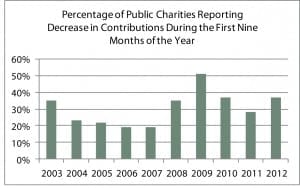As the economy has slowly begun to climb its way out of the abyss, communications budgets across many industries have stabilized. But there’s one sector that’s still fighting for budget dollars even as the economy improves: nonprofit.
Government aid designed to help organizations during the bubble is dwindling, so nonprofits are experiencing more budget fallout, as private donors scale back contributions and can’t come close to making up for government largesse. In GuideStar’s economic survey, released in January, 77% of nonprofit leaders said smaller gifts from individuals was the reason for declining contributions, followed closely by fewer individuals giving (75%).
Adding to the pressure are growing demands from nonprofit leadership and the public alike to show results, including the “overhead ratio”—the share of a nonprofit’s money that it spends on administration—which is looked at closely by potential donors, the media and charity regulators.
These challenges put the heat on nonprofit communicators, who in recent years have been charged to do more with less resources. That’s certainly the case at the Global Poverty Project (GPP), a U.K.-based nonprofit that addresses poverty and hunger throughout the world. “Capacity is a challenge,” says Justine Lucas, U.S. campaigns manager for the GPP. “Everyone works a lot of hours, but that’s what makes us stronger.”
PARTNER UP
What also makes for a stronger nonprofit in a still-tepid economy is the concept of partnerships. This was starkly evident in GPP’s 2012 Global Citizen Festival, a gathering in New York City’s Central Park included Foo Fighters and Neil Young and Crazy Horse among other performers.
The effort was supported by fellow nonprofits such as the Pratt Foundation, the Sumner M. Redstone Charitable Foundation, the Bill & Melinda Gates Foundation and Capital for Good.
“For our partners, it’s an opportunity for them to raise funds and get great media coverage,” Lucas says. In all, 60,000 people gathered on the Great Lawn to urge action in ending poverty and hunger across the globe.
Good partner relationships enable both parties to piggyback off each other’s communications efforts, Lucas says. Her tips on proper partner relations include:
• Work to create win-win—not one-way—partnerships.
• Give more of your organization than your partner gives to you.
• Connect partners with each other. “Nonprofits are very competitive, but we’ve found collaboration works better than isolation,” Lucas says.
In 2012 close to 40% of charities reported a decrease in contributions—up from just under 30% in 2011, says recent data from GuideStar.
LOOK INWARD
Another often-overlooked strategy is focusing communications efforts internally. Kristin Ludwig, director of communications at the American Society of Clinical Oncology (ASCO), says ASCO has concentrated on external efforts—engaging its 30,000-strong membership of medical professionals.
Only recently has ASCO looked inward, making sure its 280 employees are up to speed with those external PR efforts. “Engaging, interactive stories keep them even more tied to the mission,” Ludwig says.
ENGAGE WITH INNOVATION
Meanwhile, DoSomething.org’s audience of young people is a double-edged sword, says Aria Finger, the organization’s COO. On the one hand, companies understand that young people have a keen interest in giving back, and therefore want to be involved.
On the other hand, DoSomething works hard to stay on the cutting edge with its audience. “Young people expect you to be at the forefront of technology,” Finger says. “We work furiously to keep up with people who move on to the next big thing quickly.”
However, being on the cutting edge doesn’t just affect audience engagement at DoSomething. It also spills into measurement, a critical piece of the organization’s success. “It’s not just about after-the-fact metrics,” Finger says. “Measurement should inform you in everything you do.”
That’s why DoSomething’s two data scientists are the most popular people in the office, Finger adds.
IDEATION
There’s another concept that drives fiscally challenged nonprofits: ideation. While DoSomething’s staff is top-notch, the organization leans on its advisory board—which includes LinkedIn cofounder Reid Hoffman—for ideas. “Our motto is ‘the best ideas are not in the room,’” Finger says.
Ludwig confirms that great ideas will trump resources every time. “Do we have enough resources? Absolutely not,” she says. “But we’ll never run out of great ideas.” PRN
( PR News will honor the best in nonprofit communications at PR News ’ Nonprofit Awards luncheon on March 11 in Washington, D.C.—prnewsonline.com/awards/nonprofit2013-finalists.)
CONTACT:
Justine Lucas, @justinealucas; Kristin Ludwig, [email protected]; Aria Finger, @AriaIrene; Claire Johnston, [email protected].
Nonprofit PR
Measurement
Social Media
Nonprofits in 2013
6 Social Media Tips for Nonprofit Engagement
Only recently has the American Society of Clinical Oncology (ASCO) ventured into communications via social media. Within two years, the organization has launched Facebook, LinkedIn, Twitter and YouTube accounts to great results. Here are six tips from Claire Johnston, ASCO’s social media manager, on how nonprofits can best integrate social media into their communications framework.
• Chart a Course: Create a social media policy for your organization that offers guidance to employees, volunteers and leadership.
• Curate Content: Work with all members of your organization, from media to policy, to find content to post.
• Manage Your Flow: Use free or low-cost tactical tools to help manage work flow (such as Hootsuite or Engagio).
• Gauge Development: Use free or low-cost listening tools to measure content reach (Klout, SocialMention, TweetReach, TwentyFeet and Twitalyzer are just a few examples).
• Share Results: Share monthly metrics reports with your entire organization, and include visual elements that tell the story of your organization’s social media platforms.
• Try Fundraising: Social media complements traditional fundraising well (e.g. Facebook gifts and Twitter’s #GivingTuesday). Use social media at the beginning and end of a fundraising cycle, when the public’s interest is at its highest.


